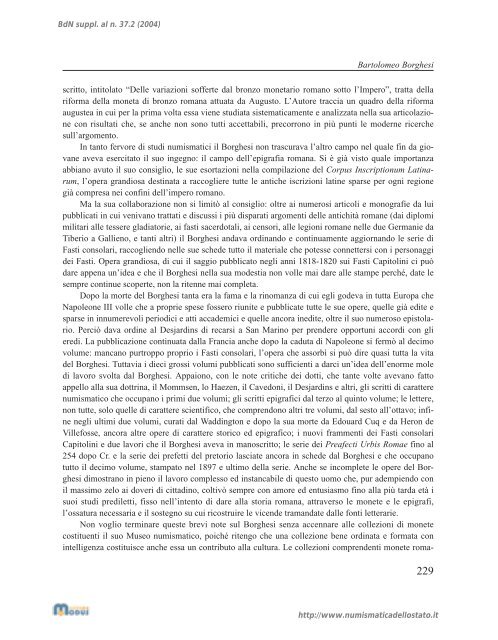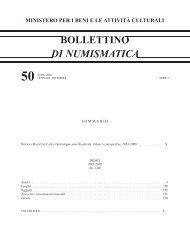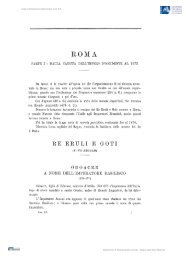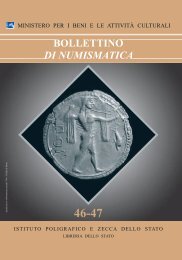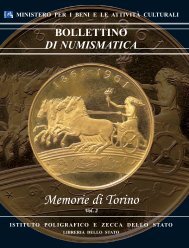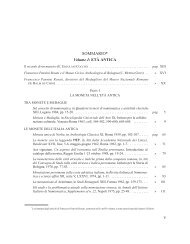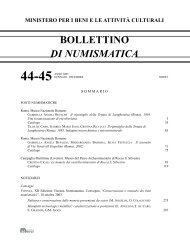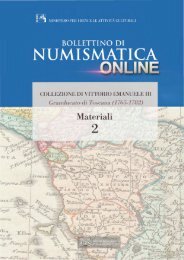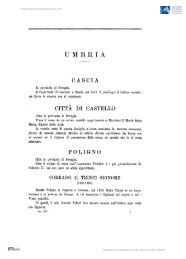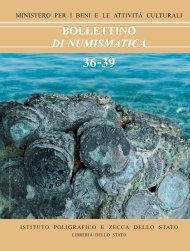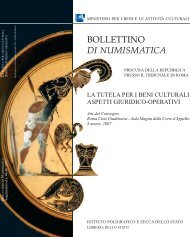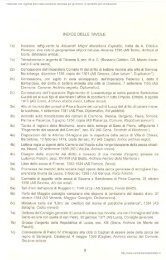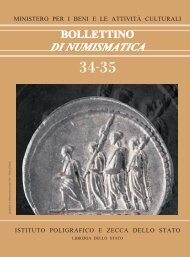Supplemento al n. 37 vol. II - MONETE E MEDAGLIE. Scritti di ...
Supplemento al n. 37 vol. II - MONETE E MEDAGLIE. Scritti di ...
Supplemento al n. 37 vol. II - MONETE E MEDAGLIE. Scritti di ...
You also want an ePaper? Increase the reach of your titles
YUMPU automatically turns print PDFs into web optimized ePapers that Google loves.
BdN suppl. <strong>al</strong> n. <strong>37</strong>.2 (2004)<br />
Bartolomeo Borghesi<br />
scritto, intitolato “Delle variazioni sofferte d<strong>al</strong> bronzo monetario romano sotto l’Impero”, tratta della<br />
riforma della moneta <strong>di</strong> bronzo romana attuata da Augusto. L’Autore traccia un quadro della riforma<br />
augustea in cui per la prima <strong>vol</strong>ta essa viene stu<strong>di</strong>ata sistematicamente e an<strong>al</strong>izzata nella sua articolazione<br />
con risultati che, se anche non sono tutti accettabili, precorrono in più punti le moderne ricerche<br />
sull’argomento.<br />
In tanto fervore <strong>di</strong> stu<strong>di</strong> numismatici il Borghesi non trascurava l’<strong>al</strong>tro campo nel qu<strong>al</strong>e fin da giovane<br />
aveva esercitato il suo ingegno: il campo dell’epigrafia romana. Si è già visto qu<strong>al</strong>e importanza<br />
abbiano avuto il suo consiglio, le sue esortazioni nella compilazione del Corpus Inscriptionum Latinarum,<br />
l’opera gran<strong>di</strong>osa destinata a raccogliere tutte le antiche iscrizioni latine sparse per ogni regione<br />
già compresa nei confini dell’impero romano.<br />
Ma la sua collaborazione non si limitò <strong>al</strong> consiglio: oltre ai numerosi articoli e monografie da lui<br />
pubblicati in cui venivano trattati e <strong>di</strong>scussi i più <strong>di</strong>sparati argomenti delle antichità romane (dai <strong>di</strong>plomi<br />
militari <strong>al</strong>le tessere gla<strong>di</strong>atorie, ai fasti sacerdot<strong>al</strong>i, ai censori, <strong>al</strong>le legioni romane nelle due Germanie da<br />
Tiberio a G<strong>al</strong>lieno, e tanti <strong>al</strong>tri) il Borghesi andava or<strong>di</strong>nando e continuamente aggiornando le serie <strong>di</strong><br />
Fasti consolari, raccogliendo nelle sue schede tutto il materi<strong>al</strong>e che potesse connettersi con i personaggi<br />
dei Fasti. Opera gran<strong>di</strong>osa, <strong>di</strong> cui il saggio pubblicato negli anni 1818-1820 sui Fasti Capitolini ci può<br />
dare appena un’idea e che il Borghesi nella sua modestia non <strong>vol</strong>le mai dare <strong>al</strong>le stampe perché, date le<br />
sempre continue scoperte, non la ritenne mai completa.<br />
Dopo la morte del Borghesi tanta era la fama e la rinomanza <strong>di</strong> cui egli godeva in tutta Europa che<br />
Napoleone <strong>II</strong>I <strong>vol</strong>le che a proprie spese fossero riunite e pubblicate tutte le sue opere, quelle già e<strong>di</strong>te e<br />
sparse in innumere<strong>vol</strong>i perio<strong>di</strong>ci e atti accademici e quelle ancora ine<strong>di</strong>te, oltre il suo numeroso epistolario.<br />
Perciò dava or<strong>di</strong>ne <strong>al</strong> Desjar<strong>di</strong>ns <strong>di</strong> recarsi a San Marino per prendere opportuni accor<strong>di</strong> con gli<br />
ere<strong>di</strong>. La pubblicazione continuata d<strong>al</strong>la Francia anche dopo la caduta <strong>di</strong> Napoleone si fermò <strong>al</strong> decimo<br />
<strong>vol</strong>ume: mancano purtroppo proprio i Fasti consolari, l’opera che assorbì si può <strong>di</strong>re quasi tutta la vita<br />
del Borghesi. Tuttavia i <strong>di</strong>eci grossi <strong>vol</strong>umi pubblicati sono sufficienti a darci un’idea dell’enorme mole<br />
<strong>di</strong> lavoro s<strong>vol</strong>ta d<strong>al</strong> Borghesi. Appaiono, con le note critiche dei dotti, che tante <strong>vol</strong>te avevano fatto<br />
appello <strong>al</strong>la sua dottrina, il Mommsen, lo Haezen, il Cavedoni, il Desjar<strong>di</strong>ns e <strong>al</strong>tri, gli scritti <strong>di</strong> carattere<br />
numismatico che occupano i primi due <strong>vol</strong>umi; gli scritti epigrafici d<strong>al</strong> terzo <strong>al</strong> quinto <strong>vol</strong>ume; le lettere,<br />
non tutte, solo quelle <strong>di</strong> carattere scientifico, che comprendono <strong>al</strong>tri tre <strong>vol</strong>umi, d<strong>al</strong> sesto <strong>al</strong>l’ottavo; infine<br />
negli ultimi due <strong>vol</strong>umi, curati d<strong>al</strong> Wad<strong>di</strong>ngton e dopo la sua morte da Edouard Cuq e da Heron de<br />
Villefosse, ancora <strong>al</strong>tre opere <strong>di</strong> carattere storico ed epigrafico; i nuovi frammenti dei Fasti consolari<br />
Capitolini e due lavori che il Borghesi aveva in manoscritto; le serie dei Preafecti Urbis Romae fino <strong>al</strong><br />
254 dopo Cr. e la serie dei prefetti del pretorio lasciate ancora in schede d<strong>al</strong> Borghesi e che occupano<br />
tutto il decimo <strong>vol</strong>ume, stampato nel 1897 e ultimo della serie. Anche se incomplete le opere del Borghesi<br />
<strong>di</strong>mostrano in pieno il lavoro complesso ed instancabile <strong>di</strong> questo uomo che, pur adempiendo con<br />
il massimo zelo ai doveri <strong>di</strong> citta<strong>di</strong>no, coltivò sempre con amore ed entusiasmo fino <strong>al</strong>la più tarda età i<br />
suoi stu<strong>di</strong> pre<strong>di</strong>letti, fisso nell’intento <strong>di</strong> dare <strong>al</strong>la storia romana, attraverso le monete e le epigrafi,<br />
l’ossatura necessaria e il sostegno su cui ricostruire le vicende tramandate d<strong>al</strong>le fonti letterarie.<br />
Non voglio terminare queste brevi note sul Borghesi senza accennare <strong>al</strong>le collezioni <strong>di</strong> monete<br />
costituenti il suo Museo numismatico, poiché ritengo che una collezione bene or<strong>di</strong>nata e formata con<br />
intelligenza costituisce anche essa un contributo <strong>al</strong>la cultura. Le collezioni comprendenti monete roma<br />
229<br />
http://www.numismaticadellostato.it


